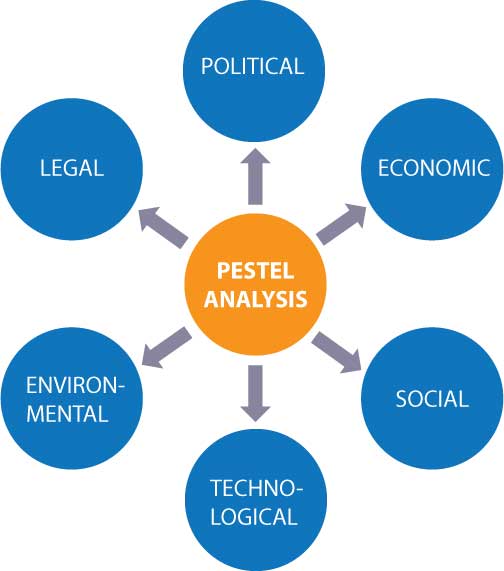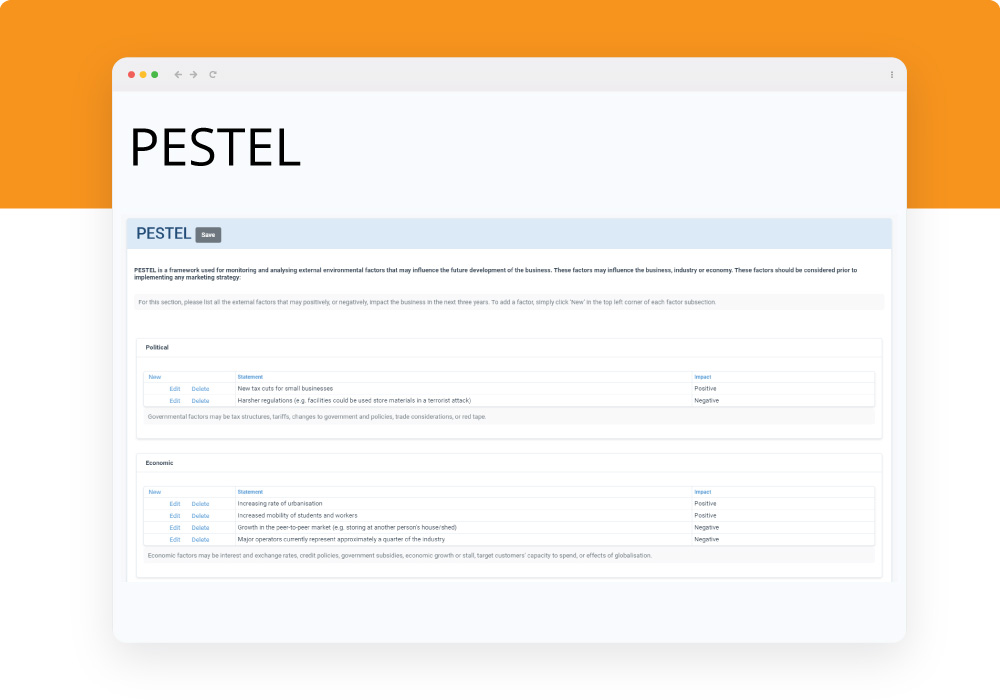Scanning the Environment: PESTEL Analysis
There are numerous macro-economic factors that can have a profound impact on the performance of a company aside from the company’s internal resources and industry factors. It is especially important to conduct careful research of these factors in order to assess the scale of their impact on the company’s success in the situations when you just launch a new product or venture.
One of the most commonly used analytical tools for assessing external macro-economic factors related to a particular situation is PESTEL Analysis, an acronym for Political, Economic, Social and Technological, Environmental and Legal factors. PESTEL is a framework used for monitoring and analysing external environmental factors that may influence the future development of the business. These factors may influence the business, industry or economy. These factors should be considered prior to implementing any marketing strategy.
Advantages of using PESTEL analysis for your business plan:
- Provides a cost-effective method and simple structure to conduct a systematic and thorough evaluation of the external macro environment.
- Facilitates an understanding of the wider business environment.
- Allows an organisation to anticipate future business threats and take action to avoid or minimise their impact.
- Creates a better understanding of your small business’ position now and in the future within the external environment and whether your business is weak or strong to cope with it.
Let’s look at the steps for conducting a PESTEL analysis.
STEP 1: Preliminary research
It is advisable to spend some time and do some preliminary research prior compiling the list of the PESTEL analysis factors. Your research can include reviewing general business trends and reading industry news publications and reports, attending industry conventions, and discussing with your staff, suppliers and customers. As you do this, make some notes of possible changes that are forecast by business and economics commentators, social researchers and other leading opinions in related fields.
STEP 2: Identify and List the PESTEL Factors
Brainstorm the PESTEL factors and identify and evaluate those that impacts your small business. List only those factors, and the change in them, in PESTEL analysis under the appropriate PESTEL headings. Consider both the present situation and likely future changes.
STEP 3: Rate PESTEL Factors Level of Impact
Individually rate the level of impact of each of the PESTEL factors on your business as ‘positive’, ‘negative’ or ‘unknown’.
STEP 4: Take Action
Moving forward, actions are needed to implement the results of the PESTEL Analysis. In general, the PESTLE Analysis should be distributed to the relevant employees/stakeholders. In addition, update your SWOT Analysis, business plan, or other strategic documentation. If there are any significant risks or threats, take appropriate steps to mitigate or eliminate them.
Here is a concise list of external factors.
Political factors
Governmental factors often include legislative bills, regulations, and laws about tax structures, tariffs, changes to government and policies, trade considerations, or red tape. Any business could be subject to them on a local, state, federal and national level. Legal factors can play a positive or negative role when new legislation is passed. These factors can impact company’s operation such as changes to trade restrictions will impact the cost of a product, – increasing or decreasing tariffs will affect the cost of products or raw materials and affect a business. Besides, political factors may even help determine the location of corporate headquarters.
Some of the political factors you need to watch are:
- Tax policies
- Stability/instability of government
- Entry mode regulations
- Funding, grants and initiatives
- Home market lobbying/pressure groups
- Freedom of press
- Government regulation and deregulation
- Social policies (social welfare etc.)
- Trade regulations (the EU & NAFTA)
Economic factors
This includes the macroeconomic factors that can affect your business directly or through your products and services, and they usually represent the metrics that measure the health of an economic region. The economic state is something that constantly evolves and will change a lot of times during the firm’s lifespan.
Examples of economic factors may include:
- Fall in consumer spending
- Housing boom
- Change in interest rates or inflation
- Unemployment rate changes
- Changes in economic growth rate
- Changes in exchange rate
- Government subsidies
- Effects of globalisation
Social factors
Social factors consider the ethical, cultural, and demographic aspects that affect the demand for a small business’s products/services and how it operates. These factors are especially important for marketers when targeting certain customers. In addition, it represent some information about the local workforce and its willingness to work under certain conditions.
The most obvious form of social change to emerge from the coronavirus crisis will be the way people feel about events, large gatherings, and returning to public spaces such as high street shops. Even after restrictions are lifted, attitudes towards close social contact are likely to see long-lasting change. How will this affect your marketing plans?
- Lifestyle trends
- Demographics – birth rates, death rates, number of marriages, number of divorces
- Shift in educational requirements and changing career attitudes
- Population growth rate
- Wealth distribution
- Immigration and emigration rates
- Family size and structure
- Buying habits
- Ethical concerns
- Cultural norms and values
Technological factors
This step implies recognising the potential technologies that are available. Technological advancements can optimise internal efficiency and help a product or service from becoming technologically obsolete. The role of technology in business is increasing each year. This trend will continue because R&D drives new innovations. This area can be very hard to predict because it is very fast-moving. The best strategy is to scan the technical press for predictions of likely disruption in the next year or so and adapt according to the changes.
One big example of a technological factor making a big impact over the past 25 years is the rise of the internet. These days many businesses worldwide have already moved to digital ways of working as a result of the lockdown, and are relying more heavily on e-commerce.
- Government expenditure on research and development
- The level of innovation
- Access to new technologies
- Disruptive technologies
- Maturity of technology
- Innovation potential
- Intellectual property issues
Environmental Factors
This section takes into account the effect of the external environment on operations. These factors have attracted attention only relatively recently. They have become important due to the increasing scarcity of raw materials, pollution targets and carbon footprint targets set by governments. Furthermore, growing awareness of the potential impacts of climate change is affecting how companies operate and the products they offer. This has led to many companies getting more and more involved in practices such as corporate social responsibility (CSR) and sustainability as both consumers and governments penalise firms for having an adverse effect on the environment. The consumers are willing to switch brands if they find a business is ignoring its environmental duties.
- Climate
- Topography
- The availability of natural resources (raw materials, mineral resources)
- Environmental pollution (emissions, waste)
- Environmental awareness
- Pressure from NGOs (Non-Governmental Organisations)
- Adoption of sustainable products
- Recycling standards
Legal factors
Legal factors can overlap with political issues, but they are focused on the effect of legislation, rather than government actions more generally. These factors cover all the legal aspects of operation, including health and safety law, discrimination laws, antitrust laws, labour and employment laws, contract laws, and elements like money-laundering laws.
Using a variety of tools
A PESTLE analysis is a useful addition to your business plan, because it gives a very precise and structured analysis of the external environment. But it is just one of several components that should go into your full marketing plan. Performing PESTEL analysis can be particularly helpful in identifying opportunities and threats to feed into a SWOT analysis, Porter’s Five Forces, competitor analysis, or scenario planning.
We recommend that the PESTEL should not, however, be used as the only analysis tool for your business plan, otherwise you will get a very one-sided picture.
For more information on how to implement and structure your marketing plan and PESTEL analysis in particular, you can get a 14-day free trial, or email us at info@planiumpro.com if you have any questions.











